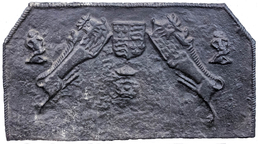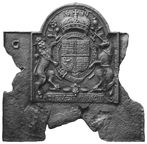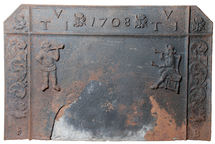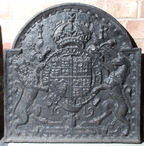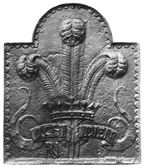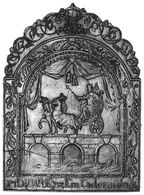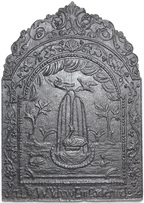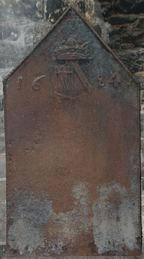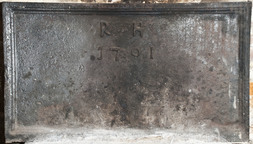-
125
Description: Canted rectangle; twisted rope edging (top and sides); top centre, Tudor royal shield between lion passant guardant to right and lion passant guardant sinister to left, both diagonally placed; below, a crowned rose; to left and right, an 'imp' with arms down, facing left.
Notes: One of a large series incorporating royal heraldic stamps. Canterbury Auction Galleries sale, 29 Nov 2017, lot 939 (£300).
Copies of this fireback are known.
Arms: Tudor royal arms of England
- Decoration tags:
- rectangular with canted top corners (shape)
- rope (edging)
- carved stamps
- heraldic
- armorial
- animals
- humans
Manufactured: in the mid-16th century in the Weald area of England.
Current location: not known.
Citation: Lloyd, N., 1925, 'Domestic Ironwork I', Architectural Review, 58, pp. 58-67.
- Attached to series:
- Royal series
-
224
Description: Composite; Arched rectangular shaped, armorial fireback, cavetto edging, with Stuart Royal arms, garter, supporters, crown and motto, and 1639 date above crown; this overlies a rectangular plate, with rope-effect, fillet edging; a pattern of four rosettes surrounding a fleur-de-lys, its stem terminating in a small buckle, is repeated on each side of the central armorial fireback, with the initials above; each rosette is stamped separately.
Notes: The armorial may originally have been one of the 1619 series. Formerly at Wonastow Court, Momouthshire
Inscription: 1639 / G / HONI SOIT QVI MAL Y PENSE / DIEV ET MO DROIT
Arms: English Stuart royal
- Decoration tags:
- rectangular with round arch (shape)
- fillet (edging)
- whole carved pattern
- composite
- individual letters
- armorial
- text
Manufactured: in 1639 possibly in the Forest of Dean area of England.
Current location: National History Museum, St Fagans, Glamorgan, Wales.
Museum number: 40.428 (part of the Welsh National History Museum museum group)
-
225
Description: Canted rectangle; cavetto moulded edging (top and sides); single horizontal fillet below canted corners and vertical fillet parallel to each side, dividing the fireback into two side panels, two top corner panels, top panel and main central panel; corner panels, ‘daisy’ plant stamp; top panel, date between ‘daisy’ stamps, between initials in triad at each end; side panels, swirling foliage stamp repeated each side above initials, I to left, B to right; centre panel, stamp of ‘Indian’ smoking a pipe at top left, stamp of seated ‘gentleman’ smoking a pipe and holding another, at top right.
Notes: The 'daisy' stamp and the IB initials are identical to those on similar firebacks dated between 1703 and 1721, and probably indicating the same founder. The use of stamps relating to tobacco smoking may suggest an origin near Bristol, the main entry port for the tobacco trade at that time. Formerly at Lilly Hall, Ledbury, Herefordshire.
Inscription: TVI [triad] 1708 TVI [triad] / I B
- Decoration tags:
- rectangular with canted top corners (shape)
- cavetto (edging)
- carved stamps
- individual letters
- individual numbers
- text
- humans
- plants
Manufactured: in 1708 in the Forest of Dean area of England.
Current location: National History Museum, St Fagans, Glamorgan, Wales.
Museum number: 13.90/2 (part of the Welsh National History Museum museum group)
- Attached to series:
- IB series
- Date & initials firebacks
-
226
Description: Arched rectangular shaped central panel with bead-and-pellet edging on a wide fillet; central pedestal with a wyvern fountain ringed with water, and a swan and a duck swimming, plants rising from the waves; above, swags of drapery with two central tassels; arched rectangular shaped border with fillet edging, symmetrical floral fronds descending from a rose, top centre, with a looped 'W' in each shoulder; inscription at base, between date; on top, symmetrical scrolled plant tendrils. A single vertical plankline right of centre.
Notes: One of a group of firebacks all of the same date, some of which have the same Welsh inscription which translates as 'God is our strength'. All incorporate the looped 'W' motif which may be intended to identify the pattern maker. The design is taken from 'Livres de Fontaines' by Daniel Marot (1661-1752) (La Haye & Amsterdam 1701). The swan and the duck swimming may have been copied from etchings or paintings by Francis Barlow (c.1624-1709), whose images of birds have been used incidentally on other firebacks. Formerly at Allt-y-ferin, Nantgaredig, Carmarthenshire.
Copies of this fireback are known.
Inscription: 17 DVW Ydyw Ein Cadernid 24
- Decoration tags:
- 'Dutch' (shape)
- fillet (edging)
- whole carved pattern
- planklines
- pictorial
- architectural
- text
- animals
- plants
- objects
Manufactured: in 1724 in England.
Current location: National History Museum, St Fagans, Glamorgan, Wales.
Museum number: 62.156 (part of the Welsh National History Museum museum group)
- Attached to series:
- 1724 series
- Welsh inscription series
- British 'Dutch' style firebacks
-
229
Description: Rectangular with superimposed arch; embattled, cavetto moulded edging, with the top edge of the rectangle interrupted; shield, garter, crown, supporters and motto of the English Royal house of Stuart; rose and thistle plants above lion and unicorn supporters respectively; initials split by crown; date below garter.
Notes: An example in the Musée d'Agen in France is illustrated by Carpentier (1912, p.419). A different version is at Newick Park, Sussex (no. 502).
Copies of this fireback are known.
Inscription: I R / HONI S OIT QVI MAL Y ..ENSE / 16 19
Arms: English Stuart royal
- Decoration tags:
- rectangular with round arch (shape)
- embattled cavetto (edging)
- whole carved pattern
- armorial
- royal
- text
Manufactured: in 1619 in England.
Current location: National History Museum, St Fagans, Glamorgan, Wales.
Museum number: 48.354/85 (part of the Welsh National History Museum museum group)
Citation: Carpentier, H., 1912, Plaques de Cheminées (Paris, published by the author).
-
234
Description: Arched rectangular shaped; cavetto moulded edging, scalloped top and sides; Prince of Wales’ badge of three ostrich feathers emerging through a coronet; symmetrical scroll with elaborate swirls, bearing motto; monogrammed initials at bottom, left of centre.
Notes: The scalloped edging and RN monogram have been noted on other firebacks, suggesting a common pattern maker. Formerly from Burwash, Sussex.
Copies of this fireback are known.
Inscription: ICH DIEN / RN
- Decoration tags:
- rectangular with round arch (shape)
- scalloped cavetto (edging)
- whole carved pattern
- heraldic
- monogram
- royal
- text
Manufactured: in the early- to mid-17th century in England.
Current location: National History Museum, St Fagans, Glamorgan, Wales.
Museum number: 20.177/1 (part of the Welsh National History Museum museum group)
- Attached to series:
- RN series
- Prince of Wales firebacks
-
238
Description: Arched rectangular shaped central panel with bead-and-pellet edging on a wide fillet; crowned figure, holding a sceptre in his right hand, sitting in a chariot drawn to the left by two, caparisoned horses with ostrich feather head-dresses; the whole upon a three-arched bridge with keystones and a string course, waves beneath; above, swagged drapery with two tassels hanging from the centre; arched rectangular shaped border with fillet edging, symmetrical, descending oak leaf and acorn branches, with a looped 'W' in each shoulder; inscription at base; on top, symmetrical scrolled plant tendrils and berries. A single central vertical plankline.
Notes: One of a series produced in the same year. All incorporate the looped 'W' motif which may be intended to identify the pattern maker. The design is derived from a personification of Europe, one of a set of playing cards entitled Jeu de la Géographie, designed by Stefano della Bella for Louis XIV. The inscription translates as 'God is our strength'.
Copies of this fireback are known.
Inscription: 17 DVW Ydyw Ein Cadernid 24
- Decoration tags:
- 'Dutch' (shape)
- fillet (edging)
- whole carved pattern
- planklines
- pictorial
- allegorical
- text
- animals
- humans
- objects
Manufactured: in 1724 in England.
Current location: Tredegar House, Pencarn Way, Duffryn, Newport, Gwent, Wales.
Museum number: F81.233 (part of the Welsh National History Museum museum group)
- Attached to series:
- 1724 series
- Welsh inscription series
- British 'Dutch' style firebacks
-
240
Description: Arched rectangular shaped central panel with bead-and-pellet edging on a wide fillet; ground with birds, and trees behind; in the centre a circular fountain rim with a swan on a plinth surrounded by water, with jets of water rising from the swan’s mouth and descending on either side; above, a heron and a goose fly to the left; under the arch, swags of drapery; arched rectangular shaped border with fillet edging, symmetrical floral fronds descending from a scallop shell, top centre, with a looed 'W' in each shoulder; inscription at base between date; on top, symmetrical scrolled plant tendrils. A single central vertical plankline.
Notes: One of a group of firebacks, all of the same date, some of which have the same Welsh inscription which translates as 'God is our strength'. All incorporate the looped 'W' motif which may be intended to identify the pattern maker. The design is adapted from an illustration of fountain no. XXXIX, 'Les Cannes et le Petit Barbet' in Labyrinthe de Versailles by Sébastien le Clerc (1677); the flying heron and duck are copied from illustrations by Francis Barlow (c1626-1704) or from engravings of his work by Wenceslaus Hollar (1607-77).
Copies of this fireback are known.
Inscription: 17 DVW Ydyw Ein Cadernid 24
- Decoration tags:
- 'Dutch' (shape)
- fillet (edging)
- whole carved pattern
- planklines
- pictorial
- architectural
- text
- animals
- objects
Manufactured: in 1724 in England.
Current location: Newton House, Dinefwr, Llandeilo, Carmarthenshire, Wales.
Museum number: F83.116 (part of the Welsh National History Museum museum group)
Citation: Lloyd, N., 1925, 'Domestic Ironwork I', Architectural Review, 58, pp. 58-67.
- Attached to series:
- 1724 series
- Welsh inscription series
- British 'Dutch' style firebacks
-
997
Description: Triangular arched shape; twisted rope edging (top and sides); top centre, shield and marquesal coronet separating two halves of date.
Notes: The arms are of Charles Paulet, 6th Marquess of Winchester (c1630-99) who married, secondly in 1655, Mary Carey, illegitimate daughter of Emanuel Scrope, 1st Earl of Sunderland and 11th Baron Scrope of Bolton; blazon: (Paulet) Sable, three swords pilewise points in base proper pommels and hilts or; (Scrope) Azure, a bend or.
Inscription: 16 84
Arms: Paulet impaling Scrope (Charles Paulet, 6th Marquess of Winchester)
- Decoration tags:
- triangular arched (shape)
- rope (edging)
- simple stamps
- carved stamps
- armorial
- text
Manufactured: in 1684 in England.
Current location: Bolton Castle, Castle Bolton, North Yorkshire, England.
- Attached to series:
- Personal armorial firebacks
- Paulet firebacks
-
1282
Description: Rectangular shape; wide fillet and ogee-moulded edging; approximately top centre, initials RH, with date 1701 centred below.
Notes: The character set for the initials and date lacks uniformity, some carved crudely, others more carefully; the lettering differs from another fireback (see no. 1166), with the same initials and date, by the position and shape of the letter 'R'. Formerly at Nethercote, Netherfield Hill, East Sussex. The former location in the Netherfield area of these two firebacks suggests a possible association with Richard Hay, owner of land in that area at that time and ironmaster at Beech Furnace nearby.
Inscription: R H / 1701
- Decoration tags:
- rectangular (shape)
- fillet and ogee (edging)
- carved stamps
- individual letters
- individual numbers
- text
Manufactured: in 1701 possibly at Beech Furnace, Battle in the Weald area of England.
Current location: in private hands, Catsfield, East Sussex, England.
- Attached to series:
- Date & initials firebacks
